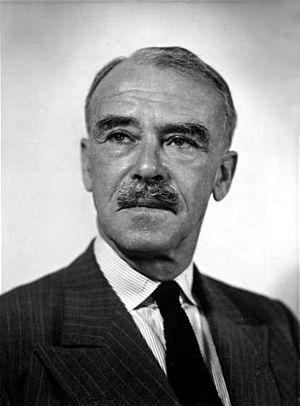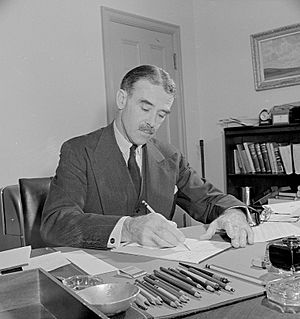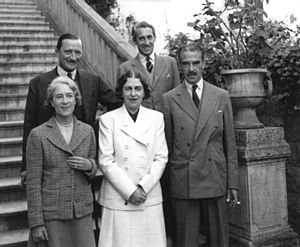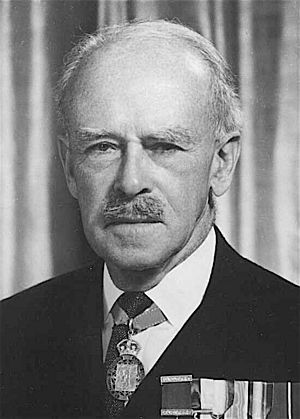Richard Casey, Baron Casey facts for kids
Quick facts for kids
The Lord Casey
|
|
|---|---|

Casey in 1954
|
|
| 16th Governor-General of Australia | |
| In office 7 May 1965 – 30 April 1969 |
|
| Monarch | Elizabeth II |
| Prime Minister | Sir Robert Menzies (1965–66) Harold Holt (1966–67) John McEwen (1967–68) John Gorton (1968–69) |
| Preceded by | The Viscount De L'Isle |
| Succeeded by | Sir Paul Hasluck |
| Minister for External Affairs | |
| In office 11 May 1951 – 4 February 1960 |
|
| Prime Minister | Robert Menzies |
| Preceded by | Percy Spender |
| Succeeded by | Robert Menzies |
| Minister for External Territories | |
| In office 26 April 1951 – 11 May 1951 |
|
| Prime Minister | Robert Menzies |
| Preceded by | Percy Spender |
| Succeeded by | Paul Hasluck |
| Minister in charge of the CSIRO | |
| In office 23 March 1950 – 4 February 1960 |
|
| Prime Minister | Robert Menzies |
| Preceded by | Office established |
| Succeeded by | Donald Alastair Cameron |
| Minister for Works and Housing | |
| In office 19 December 1949 – 17 March 1950 |
|
| Prime Minister | Robert Menzies |
| Preceded by | Nelson Lemmon |
| Succeeded by | Wilfrid Kent Hughes |
| Governor of Bengal | |
| In office 14 January 1944 – 19 February 1946 |
|
| Preceded by | John Herbert |
| Succeeded by | Frederick Burrows |
| Minister to the United States of America | |
| In office 1 February 1940 – 20 April 1942 |
|
| Prime Minister | Robert Menzies (1940–41) Arthur Fadden (1941) John Curtin (1941–42) |
| Preceded by | Office established |
| Succeeded by | Sir Owen Dixon |
| Treasurer of Australia | |
| In office 3 October 1935 – 26 April 1939 |
|
| Prime Minister | Joseph Lyons (1935–39) Sir Earle Page (1939) |
| Preceded by | Joseph Lyons |
| Succeeded by | Robert Menzies |
| Member of the United Kingdom House of Lords Lord Temporal |
|
| In office 16 May 1960 – 17 June 1976 |
|
| Member of the Australian Parliament for La Trobe |
|
| In office 10 December 1949 – 10 February 1960 |
|
| Preceded by | Division created |
| Succeeded by | John Jess |
| Member of the Australian Parliament for Corio |
|
| In office 19 December 1931 – 30 January 1940 |
|
| Preceded by | Arthur Lewis |
| Succeeded by | John Dedman |
| Personal details | |
| Born |
Richard Gavin Gardiner Casey
29 August 1890 Brisbane, Queensland, Australia |
| Died | 17 June 1976 (aged 85) Fitzroy, Victoria, Australia |
| Political party | United Australia (before 1945) Liberal (after 1945) |
| Spouse | |
| Alma mater | University of Melbourne Trinity College, Cambridge |
| Profession | Diplomat, politician |
| Military service | |
| Allegiance | Australia |
| Branch/service | Australian Imperial Force |
| Years of service | 1914–1919 |
| Rank | Major |
| Awards | Distinguished Service Order Military Cross Mentioned in Despatches (2) |
Richard Gavin Gardiner Casey, Baron Casey (29 August 1890 – 17 June 1976) was an important Australian leader. He served as the 16th Governor-General of Australia from 1965 to 1969.
Casey was also a brave army officer and a long-serving government minister. He was Australia's Ambassador to the United States. During World War II, he was part of Winston Churchill's special War Cabinet. He also served as the Governor of Bengal in India.
Casey was born in Brisbane, Australia. He later moved to Melbourne and studied engineering. He continued his studies at Trinity College, Cambridge in England. In 1914, he joined the Australian Army. He fought in the Gallipoli Campaign and on the Western Front. He became a major and won two important awards for bravery.
After the war, Casey worked for the Australian government in London. In 1931, he became a member of the Australian Parliament. He held many important jobs, including Treasurer (in charge of the country's money). During World War II, he became Australia's first Ambassador to the United States. He also helped manage the recovery from a terrible famine in Bengal, India.
Casey returned to Australia in 1946. He helped lead the new Liberal Party. He became a Member of Parliament again in 1949. He served as Minister for External Affairs (dealing with other countries) until 1960. In 1965, he was chosen to be the Governor-General. He served for almost four years.
The City of Casey in Greater Melbourne is named after him.
Contents
Growing Up and Learning
Richard Gavin Gardiner Casey was born in Brisbane, Queensland. He later dropped "Gavin" from his name. His father, also named Richard, was a rich farmer and a politician. His mother, Evelyn, also came from a wealthy family.
In 1893, his family moved to Melbourne. His father became a successful company director. Richard went to school in Melbourne. He studied engineering at the University of Melbourne. He then went to Trinity College, Cambridge in England. He earned a degree in mechanical sciences in 1913.
Military Service and Early Career
When World War I started in 1914, Casey joined the Australian Army. He became a lieutenant. He was part of the first group of soldiers to leave Australia. He helped guard German prisoners after a famous sea battle.
He served bravely at Gallipoli. He was an assistant to Major General Sir William Bridges. Casey was standing right next to Bridges when he was shot. Later, Casey fought in France. He earned the Military Cross and was promoted. He also received the Distinguished Service Order in 1918 for his courage. He left the army in 1919.
After the war, Casey took over his father's businesses. These included engineering and mining companies. In 1924, Australia's Prime Minister, Stanley Bruce, asked him to work in London. Casey sent secret reports on politics and money back to Australia. In 1926, he married Maie Ryan. They had two children together.
Before World War II: A Political Start
In 1931, Casey returned to Australia. He was elected to the House of Representatives. He represented the area of Corio. The Prime Minister, Joseph Lyons, made him an assistant minister in 1933. In 1935, he became the Treasurer. This meant he was in charge of Australia's money.
In 1939, Robert Menzies became Prime Minister. He made Casey the Minister for Supply and Development. In 1940, Casey left Parliament. Menzies appointed him as Australia's first Ambassador to the United States. This was a very important job during wartime. Casey helped build a strong friendship between the US and Australia.
World War II Roles
In 1942, Winston Churchill asked Casey to move to Cairo. He became the Minister-Resident for the Middle East. In this role, he helped different governments and military leaders work together.
In 1944, Casey was appointed Governor of Bengal in India. He held this job until 1946. He had to deal with the effects of a terrible famine that happened in 1943. He also faced growing demands for India's independence from Britain.
After the War: Back in Politics
Casey came back to Australia in 1946. He hoped to become the leader of the new Liberal Party. He turned down a British title to keep his chances in Australian politics. He became the Federal President of the Liberal Party in 1947. He was very good at raising money for the party.
The Liberal Party won the election in 1949. Casey returned to Parliament. He represented the area of La Trobe. Prime Minister Menzies gave him several important jobs. In 1951, he became the Minister for External Affairs. This meant he handled Australia's relationships with other countries. He held this job during the Cold War and other big world events.
Casey was also in charge of the CSIRO. This is Australia's national science agency. He was very dedicated to its success. In 1960, he was given a special title, Baron Casey. He became a member of the British House of Lords. He then left his jobs in the Australian government.
Serving as Governor-General
In 1965, Queen Elizabeth II appointed Lord Casey as the Governor-General. This was a big moment because it was the first time an Australian, who wasn't from the Labor Party, was chosen for this role. It also marked the end of non-Australians being appointed to the job.
Casey was not sure about taking the job at first. He asked for a two-year term instead of the usual five. But he ended up serving for three and a half years.
In 1967, Prime Minister Harold Holt disappeared. This was a very difficult time for Australia. Casey had to decide who would lead the country next. He chose John McEwen, the leader of the Country Party. This decision was important for keeping the government stable.
Casey finished his term in 1969. He and his wife retired to their farm in Berwick. He passed away on 17 June 1976. He is buried in Mount Macedon cemetery.
Honours and Legacy
Richard Casey received many awards for his service. He earned the Military Cross and the Distinguished Service Order during World War I. He was also mentioned in official reports twice for his bravery.
In 1944, he was made a Companion of the Order of the Companions of Honour. In 1960, he became "Baron Casey". This made him a life peer in the British House of Lords. In 1965, he was made a Knight Grand Cross of the Order of St Michael and St George. In 1969, he became a Knight of the Order of the Garter, a very high honour. He was also named Australian of the Year in 1969.
Many places are named after him. The area where his farm was is now called the City of Casey. There is also a federal voting area called the Division of Casey. The suburb of Casey in Canberra is named after him. Even Casey Station, an Australian base in Antarctica, honours his name. The R. G. Casey Building in Canberra is the main office for Australia's Department of Foreign Affairs and Trade.






